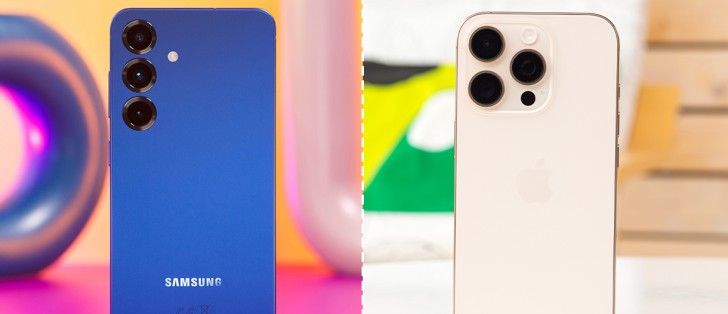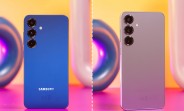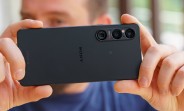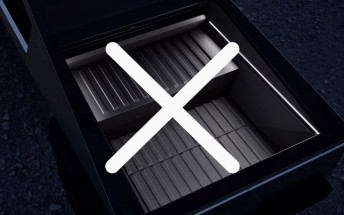Samsung Galaxy S25 vs. Apple iPhone 16 Pro

So, you are in the market for a powerful compact flagship phone, and you are ready to dig deep in your pocket for one of the world's heavy-hitters, the Samsung Galaxy S25 and the Apple iPhone 16 Pro? In case, of course, you are not necessarily invested in either ecosystem.
Well, the two devices are very different when it comes to hardware, software and price. The only common ground they share is footprint. These are the latest and greatest compact premium solutions from Samsung and Apple, so it's only natural to put them head to head.
Table of Contents:
For starters, you can compare the complete specs sheets or directly continue with our editor's assessment in the following video or in the text below.
Size comparison
If portability is a top priority, then the Galaxy S25 is the clear answer here. Sure, it houses a slightly smaller display, 0.1" smaller, but it's considerably more compact in real life. It's shorter, narrower and thinner, so it feels like a much smaller device in hand. Not to mention lighter.

The Galaxy S25 is more than 30 grams lighter than its competitor, and although that doesn't sound like much, it's a huge difference in hand.
Build quality-wise, the iPhone has a slight advantage since it features the latest and greatest Apple can offer (titanium frame and Ceramic Shield glass), while the Galaxy S25 is a step down from the S25 Ultra with an aluminum frame and Gorilla Glass Victus 2.
Ingress protection is matched at IP68, though Apple certifies their devices to withstand immersion at a much greater depth than Samsung (6m vs 1.5m).
Display comparison
Both devices offer excellent displays and are very similar in size too. However, the iPhone takes the lead with Dolby Vision support, slightly higher resolution (not that it matters much) and is also brighter. Don't get us wrong, the S25's panel is perfectly fine even in the brightest of days, but the iPhone 16 Pro's max brightness is hard to ignore - mid 1,700 nits vs. almost 1,400 nits.
Keep in mind the notch, though. Even though Apple uses it as a feature, it takes considerably more screen real estate than the punch-hole for the selfie cam on the S25.
Battery life
If we strictly look at the Active Use Score, one could argue the iPhone 16 Pro has only marginally better battery life. The Galaxy S25 even has a longer call runtime and slightly better gaming score, but the 16 Pro outperforms the S25 in web browsing/social network scrolling by a landslide while offering a slightly better video streaming score too, which are arguably the main two uses for modern-day smartphones.
Charging speed
Neither device has an impressive charging rate, and it's also hard to determine the winner here. According to our tests, the Galaxy S25 is the clear winner of the full charging cycle by outpacing the iPhone 16 Pro by around 21 minutes.
Conversely, the iPhone 16 Pro beats the S25 to the first two checkpoints at 15 and 30 minutes by a few percentages. Still, we'd give the Galaxy S25 the win since it's meaningfully faster at the finish, while the iPhone is only negligibly quicker in the first 30 minutes.
Speaker test
The Galaxy S25 and the iPhone 16 Pro trade blows in this category, with the former winning in the loudness comparison and the latter by offering better tuning or sound quality, however you like to call it.
We find the iPhone 16 Pro's tuning warmer with more expressive bass, so tracks sound fuller and livelier.
Performance
The Galaxy S25 relies on Qualcomm's latest and greatest Snapdragon 8 Elite for Galaxy, with the "for Galaxy" designation suggesting slightly higher clocks on the main CPU cores and the GPU compared to the standard chipset used in other Android phones.
The iPhone 16 Pro, on the other hand, runs on an in-house designed chip, Apple A18 Pro, which historically has outperformed its competitors, but not this year.
Both devices offer 128GB of internal storage by default, which is pretty low for a high-end smartphone, but while the S25 can give you 512GB at best, the 16 Pro has a 1TB version. The 16 Pro's NVMe storage is notably faster than the S25's UFS 4.0 too. The 128GB version of the Galaxy also probably uses slower storage than that as UFS 4.0 is only available in sizes 256GB and up.
Notably, all iPhone 16 Pro configurations have 8GB of RAM, while the S25 runs on 12GB, no matter the storage.
Benchmark performance
As we pointed out earlier, Apple's silicon has historically been more powerful than its peers, but this year, Qualcomm outdid itself and introduced a significantly more powerful chip. The Snapdragon 8 Elite for Galaxy outperforms the A18 Pro in multi-core scenarios by 21%, at least in this particular comparison between the Galaxy S25 and the iPhone 16 Pro. In GPU-heavy workloads like 3DMark's Wild Life Extreme, the S25 beats the iPhone 16 Pro by around 38%.
Camera comparison
The two devices feature very different camera hardware. Judging solely by the specs sheet, the iPhone 16 Pro is the clear winner here. It has a bigger main 48MP sensor, a 12MP telephoto camera with 5x optical zoom, and a more potent 48MP ultrawide camera.
The Galaxy S25 sits in the opposite corner with a 50MP main camera, 10MP telephoto shooter with 3x optical zoom and 12MP ultrawide snapper.
The selfie game of both handsets is very good - 12MP front-facing shooter with autofocus for the Galaxy S25 and 12MP selfie, autofocus-enabled unit for the iPhone 16 Pro.
Image quality
Off to the actual camera comparison. In daylight, we see a similar quality with a slight advantage of the iPhone 16 Pro. In almost all cases, the iPhone 16 Pro will give you sharper stills with a bit more detail and a wider dynamic range. And that's even before you turn on the 24MP mode.
We were surprised by the Galaxy S25's ability to shoot in 5x, though, as it gets pretty close to the iPhone 16 Pro in daylight scenarios.





Galaxy S25: 0.6x • 1x • 2x • 3x • 5x





iPhone 16 Pro: 0.6x • 1x • 2x • 3x • 5x
At night, the two phones' main cameras are quite close in image quality, but the Galaxy S25 produces better detail and brighter exposure if you prefer that.
However, the iPhone 16 Pro has much better 2x photos.
The Galaxy S25 regains superiority in 3x zoom, but that's to be expected given that it has a dedicated 3x telephoto unit.
On the other hand, the 16 Pro has a 5x camera, which produces nicer photos at its corresponding focal length.
And finally, the Galaxy S25's ultrawide camera provides much better nighttime exposure, detail, and dynamic range.





Galaxy S25: 0.6x • 1x • 2x • 3x • 5x





iPhone 16 Pro: 0.6x • 1x • 2x • 3x • 5x
Video quality
Below, we have a few framegrabs from the videos taken by the two phones at each focal length so it's easier to compare to one another.





Galaxy S25 video framegrabs: 0.6x • 1x • 2x • 3x • 5x





iPhone 16 Pro video framegrabs: 0.6x • 1x • 2x • 3x • 5x
Video recording is where the iPhone 16 Pro excels. The 16 Pro delivers noticeably better videos night and day except for the ultrawide camera, where the two devices produce somewhat similar videos and in the 3x zoom mode, where the Galaxy S25 has an edge due to its physical zoom cam.





Galaxy S25 video framegrabs: 0.6x • 1x • 2x • 3x • 5x





iPhone 16 Pro video framegrabs: 0.6x • 1x • 2x • 3x • 5x
Verdict
The Galaxy S25 and the iPhone 16 Pro are definitely among the best compact flagship phones out there. However, the iPhone 16 Pro seems like the better phone overall, with its brighter display, better camera system, longer battery life and better-sounding speakers. But it's also the more expensive phone too. It sells for a little over €1,000 in Europe and $1,000 in the US, so it costs as much as a Galaxy S25+ (when you equate for storage), while the Galaxy S25 asks €800/$800. That's a 200 bucks difference, which can hardly go unnoticed.
In addition to the outlined advantages, the iPhone has UWB support, satellite messaging and a more premium build. These are not necessarily game-changer features, but some of you may appreciate them. It's also important to consider biometric security as the iPhone 16 Pro offers only Face ID, while the Galaxy S25 has an ultrasonic under-display fingerprint reader. We leave to you to decide which one is better.
On the other hand, the Galaxy S25 is lighter and more compact than the two, it's slightly faster to charge, packs more raw horsepower under the hood and is notably cheaper. And if you are into that AI stuff, you can enjoy most of the features on Samsung's One UI software right away, whereas Apple is yet to deliver all of its planned AI-powered features, let alone release them in Europe.
- The more lightweight and compact design.
- The slightly faster charging.
- The under-display fingerprint reader.
- The more powerful chipset.
- The readily available AI features.
- The lower price tag.
- The 3x optical zoom camera.










 Xiaomi
Xiaomi Samsung
Samsung Samsung
Samsung Nothing
Nothing OnePlus
OnePlus


